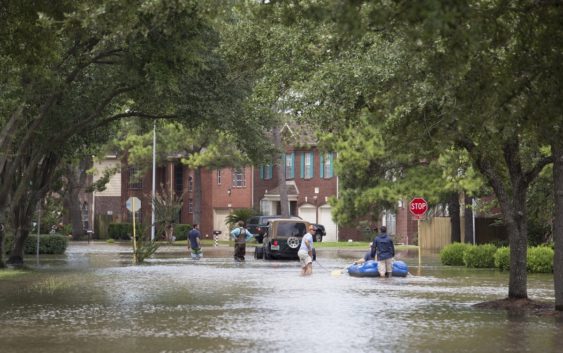- Fake job seekers are flooding the market, thanks to AI
- One set of evacuation orders lifted in Caldwell County after wildfire contained
- 'We gutted every building' | Chimney Rock rebuilding after Hurricane Helene
- 'We gutted every building' | Chimney Rock rebuilding after Hurricane Helene
- Debris from Hurricane Helene provides fuel, complicates containment for spring wildfires
Federal judge dismisses suit against Army Corps for post-Harvey flooding

A federal judge has ruled that the U.S. Army Corps of Engineers isn’t liable for flood damage to thousands of Houston homes after the agency cracked open the gates on two massive dams in the wake of Hurricane Harvey.
In a brusque, 19-page ruling that granted the government’s request to dismiss the case, U.S. Judge Loren A. Smith of the Court of Federal Claims said the homes downstream of the dams, called Addicks and Barker, would have flooded regardless of how the Army Corps operated them. That’s because of Harvey’s unprecedented nature, he wrote.
“This storm, which overwhelmed the system’s capacity was classified as a once in 2000-year event, which means the last such event occurred during the life of Jesus!” Smith wrote. “The answer of what caused the damage is thus inescapable to the Court’s eye and mind. The damage was caused by Hurricane Harvey, and such a hurricane is an Act of God, which the government neither caused nor committed.”
The Army Corps’ operation of Addicks and Barker became a major flashpoint — and the subject of sweeping legal actions — in the wake of Harvey as thousands of homes located both upstream and downstream of the dams flooded. Back when the agency built the earthen structures in the 1940s after back-to-back storms left downtown Houston underwater, they were in the middle of an open prairie some 15 miles from the heart of the city. But since then, rapid growth has encroached from all sides.
During Harvey, the reservoirs behind the dams got so full that the Army Corps made the decision to release a torrent into Buffalo Bayou, which has been boxed in by development.
Those “controlled releases” — which the Army Corps ramped up significantly after the storm had moved on — propelled water into thousands of homes and businesses that wouldn’t have otherwise flooded and whose owners thought they had emerged from the worst rainstorm in modern U.S. history largely unscathed.
Those who chose to sue alleged that the Army Corps’ decision to open the floodgates on the dams — knowing that it might flood additional homes — constituted a governmental land seizure that requires “just compensation” under the Fifth Amendment to the U.S. Constitution.
“We strongly disagree with this ruling,” the law firm McGehee Chang, Landgraf, Feiler, which represented some downstream property owners, wrote in a post on its website.
The lawyers said the ruling is contrary to one issued in December by another federal judge who ruled in favor of flood victims who live upstream of the reservoirs, including in areas the Army Corps knew could flood if a large enough storm hit.
“Further, Judge Smith’s ruling is also contrary to other case precedents, either from the Supreme Court or the Court of Federal Claims (this very court),” the post said. “We will convene the Downstream litigation team and explore our option to appeal this ruling to the court of appeals.”
Other law firms that represented downstream plaintiffs in the case said they were still reviewing the decision, which came after business hours on Tuesday. The U.S. Department of Justice did not immediately respond to a request for comment.
Though both upstream and downstream flood victims alleged in their lawsuits that the flooding of their properties constituted a governmental land seizure, Smith highlighted a key difference between the arguments in concluding that the analysis laid out by his colleague, U.S. Judge Charles F. Lettow, in December “is not relevant” to his own.
Lettow determined that the flooding of upstream property occurred “as a result of the general operation of the Addicks and Barker” dams and “as a direct result of the Corps’ decision to close the floodgates in order to protect properties downstream at the expense of the upstream properties.” Smith wrote that “In contrast, the Downstream plaintiffs do not allege that the general operation of the Reservoirs caused the flooding of their property.”
“The downstream plaintiffs’ theory of causation ignores the simple fact that the gates were initially closed for the sole purpose of protecting their properties from floodwaters, that such mitigation failed because the impounded storm waters exceeded the Reservoirs’ controllable capacity, and that the Harvey was the sole and proximate cause of the floodwaters.”
He also said that neither state or federal law guarantees “the right to perfect flood control.”
“Plaintiffs allege that the government could have done more to ensure perfect flood control efforts, and because the government did not do more, it failed to stop the flooding of their lands,” he wrote. “Of course, the water from the hurricane was not the government’s water, unless the storm was also created by the government’s wind and air and sun and sky. These were flood waters that no entity could entirely control.”